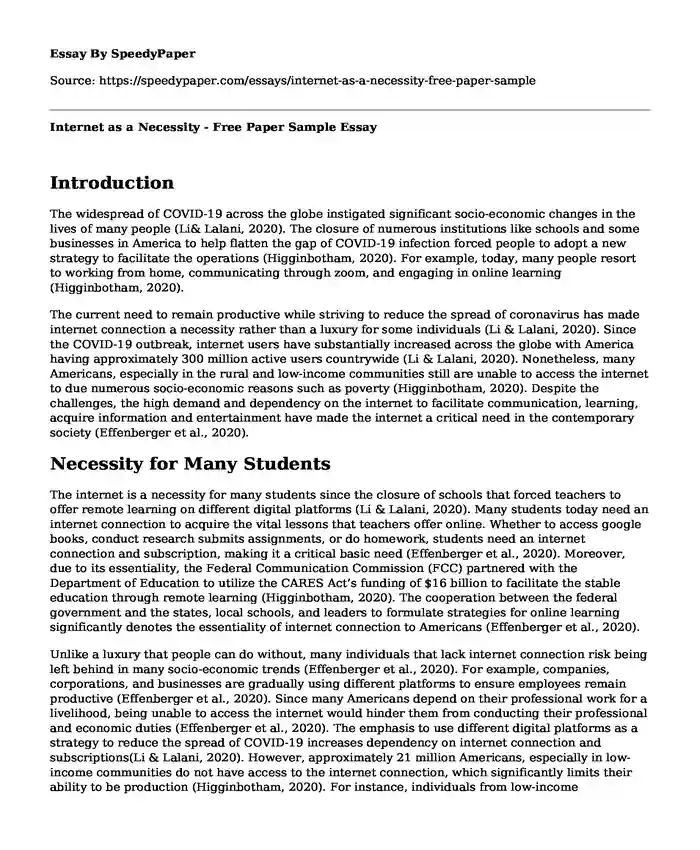Introduction
The widespread of COVID-19 across the globe instigated significant socio-economic changes in the lives of many people (Li& Lalani, 2020). The closure of numerous institutions like schools and some businesses in America to help flatten the gap of COVID-19 infection forced people to adopt a new strategy to facilitate the operations (Higginbotham, 2020). For example, today, many people resort to working from home, communicating through zoom, and engaging in online learning (Higginbotham, 2020).
The current need to remain productive while striving to reduce the spread of coronavirus has made internet connection a necessity rather than a luxury for some individuals (Li & Lalani, 2020). Since the COVID-19 outbreak, internet users have substantially increased across the globe with America having approximately 300 million active users countrywide (Li & Lalani, 2020). Nonetheless, many Americans, especially in the rural and low-income communities still are unable to access the internet to due numerous socio-economic reasons such as poverty (Higginbotham, 2020). Despite the challenges, the high demand and dependency on the internet to facilitate communication, learning, acquire information and entertainment have made the internet a critical need in the contemporary society (Effenberger et al., 2020).
Necessity for Many Students
The internet is a necessity for many students since the closure of schools that forced teachers to offer remote learning on different digital platforms (Li & Lalani, 2020). Many students today need an internet connection to acquire the vital lessons that teachers offer online. Whether to access google books, conduct research submits assignments, or do homework, students need an internet connection and subscription, making it a critical basic need (Effenberger et al., 2020). Moreover, due to its essentiality, the Federal Communication Commission (FCC) partnered with the Department of Education to utilize the CARES Act’s funding of $16 billion to facilitate the stable education through remote learning (Higginbotham, 2020). The cooperation between the federal government and the states, local schools, and leaders to formulate strategies for online learning significantly denotes the essentiality of internet connection to Americans (Effenberger et al., 2020).
Unlike a luxury that people can do without, many individuals that lack internet connection risk being left behind in many socio-economic trends (Effenberger et al., 2020). For example, companies, corporations, and businesses are gradually using different platforms to ensure employees remain productive (Effenberger et al., 2020). Since many Americans depend on their professional work for a livelihood, being unable to access the internet would hinder them from conducting their professional and economic duties (Effenberger et al., 2020). The emphasis to use different digital platforms as a strategy to reduce the spread of COVID-19 increases dependency on internet connection and subscriptions(Li & Lalani, 2020). However, approximately 21 million Americans, especially in low-income communities do not have access to the internet connection, which significantly limits their ability to be production (Higginbotham, 2020). For instance, individuals from low-income communities cannot efficiently participate in remote schooling and work programs due to the inexpensive cost of the internet (Higginbotham, 2020). Despite the FCC approved $20.4 billion Rural Digital Opportunity Fund aimed at narrowing the digital gap between the rich and the poor, and between urban and rural regions, many Americans still struggle to access the vital commodity (internet connection) (Higginbotham, 2020).
Conclusion
Conclusively, internet connection and subscription have become an essential commodity and a basic need for students and the working population since the outbreak of COVID-19. With the closure of schools and businesses to flatten the curve of COVID-19, many people and institutions resorted to using digital platforms to facilitate communication, conduct business, access information, and engage in learning activities that require internet connection. Unlike a luxury, which people can do without, today, internet connection is a necessity that forces many people to adjust their schedules and budget to access the internet for communication, learning, and business transactions.
References
Effenberger, M., Kronbichler, A., Shin, J. I., Mayer, G., Tilg, H., & Perco, P. (2020). Association of the COVID-19 pandemic with internet search volumes: a google trends analysis. International Journal of Infectious Diseases. 95(1). https://doi.org/10.1016/j.ijid.2020.04.033
Higginbotham, S. (2020). COVID-19 makes it clear that broadband access is a human right. IEEE Spectrum. https://spectrum.ieee.org/telecom/internet/covid19-makes-clear-broadband-access-is-human-right
Li, C., &Lalani, F. (2020). The COVID-19 pandemic has changed education forever: This is how. World economic forum. https://www.weforum.org/agenda/2020/04/coronavirus-education-global-covid19-online-digital-learning/.
Cite this page
Internet as a Necessity - Free Paper Sample. (2023, Nov 25). Retrieved from https://speedypaper.com/essays/internet-as-a-necessity-free-paper-sample
Request Removal
If you are the original author of this essay and no longer wish to have it published on the SpeedyPaper website, please click below to request its removal:
- Free Essay: Abortion Comparison Between Urban and Rural Cities
- Free Essay Example on Information Technology in Healthcare
- Essay Sample Dedicated to Euthanasia Decriminalization
- Essay Example on Preventive Care Within the Health Unit
- Free Essay Example. Big Data Hype or Mining
- Essay Sample. The History of Information Communication Technology
- Paper Example: Science, Technology and Progress
Popular categories





